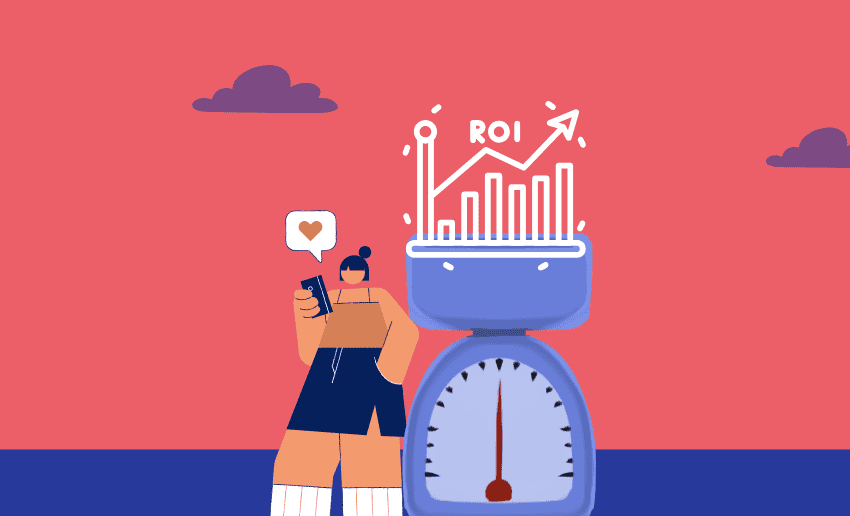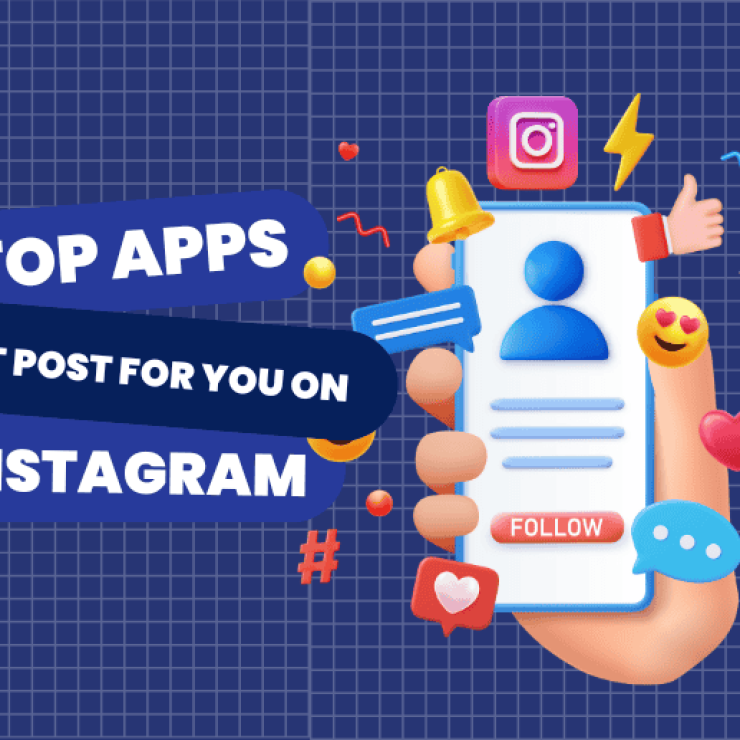Every brand wants to know if their social media efforts are truly paying off. This makes understanding how to measure social media ROI an essential knowledge. Social Media ROI simply means finding out what you are getting in return for the time, money, and energy you invest in platforms like Instagram, Facebook, TikTok, or LinkedIn.
However, measuring success on social media isn’t always easy. While likes, comments, and shares can show engagement, they don’t always translate directly into sales or leads. And for brands to truly know what they get fro these efforts, they must look at both quantitative metrics (such as conversions and clicks) and qualitative results (such as brand awareness and customer loyalty).
In this guide, you’ll learn step-by-step how to track your social media ROI, use the right social media ROI formula, and calculate social media ROI accurately. With this, you’ll be able to connect your social media results to real business growth and make smarter marketing decisions.
Social Media ROI stands for Return on Investment from your social media activities. It measures how much value your social media marketing brings compared to how much you spend on it. With this knowledge, brands, businesses and creators now understand whether their campaigns are actually helping their business grow or just getting attention without results.
ROI shows the relationship between the benefits you gain and the costs you invest. For example, if you spend money running ads or creating content, your ROI tells you whether those efforts led to something valuable like more sales, leads, or website traffic.
The returns can be both monetary and non-monetary. Monetary results include things you can count in money, such as product sales, paid subscriptions, or lead conversions. Non-monetary results include valuable outcomes like higher brand awareness, stronger audience engagement, or improved customer loyalty all of which also contribute to long-term success.
Measuring social media ROI is more than just tracking likes and comments as it gives you an insight into how your efforts truly impact your business goals. The benefit attached to knowing your social media ROI is inmerse with the most popular including:
1. Justify your social media budget
You cannot confidently ask for more resources or defend your existing spend unless you measure social media ROI. Leadership and stakeholders will want proof that your campaigns are worth the cost.
And with competition becoming more fierce, marketers now worry about proving ROI from social efforts. When you track your social media ROI, you can present real numbers not guesses to secure future budgets.
2. Identify what works
Measuring ROI also lets you learn which tactics generate returns and which waste resources. Using the social media ROI formula or tracking conversions will help you spot low-performing campaigns. This insight lets you double down on winning content or ads and cut or adjust the underperforming ones. This keeps your strategy lean and effective.
3. Align social media with business goals
Measuring ROI forces you to tie social activities to real business objectives and not just vanity metrics like likes or shares. When you calculate social media ROI, you connect your efforts to outcomes like leads, sales, or customer retention. This alignment ensures social media becomes part of your core growth strategy and not just a marketing “side show.”
4. Improve decision making
Relying on gut feeling is risky but when you track your social media ROI, you get data-driven feedback on which platforms, content types, or audiences deliver the best return. This clarity helps you decide where to invest more or less, which experiments to run, and how to optimize your campaigns moving forward.
5. Build credibility
Marketing often faces skepticism because its gains aren’t always obvious. But when you can show a positive ROI calculation, you prove that social media is contributing real value. That builds trust among leaders, clients, or investors and positions your team as accountable and strategic.
6. Compete smarter
In a crowded digital space, you need to stay ahead. Measuring ROI lets you benchmark your performance against your own past or against competitors. If you see your returns lagging, you know it’s time to adapt or innovate. This data-driven approach helps you stay agile and competitive.
7. Balance short-term gains and long-term value
Social media brings both immediate results (sales, sign-ups) and long-term benefits (brand awareness, loyalty). If you only look at short-term numbers, you’ll miss the bigger picture. Measuring ROI allows you to measure both quantitative and qualitative returns.
Knowing how to measure social media ROI helps you understand whether your marketing efforts are truly delivering value or just generating noise. It shows how much return you get for the time, money, and creativity invested in each platform.
Here are practical strategies to help you track, calculate, and improve your social media ROI effectively:
1. Have a clear social media direction
Setting specific or detailed goals (Specific, Measurable, Achievable, Relevant, Time-bound) gives you a clear target, which makes it easier to track your social media ROI realistically. For example, instead of “grow followers,” a SMART goal would be “increase Instagram followers by 10% in the next 90 days.”
When goals are well defined, you can pick appropriate social media KPIs for ROI that align with them. Typical objectives include brand awareness, user engagement, lead generation, or sales conversion. To measure progress, you can monitor metrics like reach, clicks, conversions, and cost per result (or cost per action) to see which strategies are working best.
2. Breakdown each campaign
To measure social media ROI accurately, it’s not enough to look at overall engagement. You need to focus on specific campaigns. Broad insights from your entire social presence can be too general to guide real business actions. Instead, zoom in on each campaign and define clear, measurable goals before you begin.
A campaign should have a focused purpose with trackable outcomes. This could include:
- Growing your email list
- Increasing contact form submissions
- Getting more free trials or demos
- Driving purchases or sign-ups
- Boosting downloads of guides, whitepapers, or eBooks
Once you’ve chosen your goal, make sure you’re tracking every result properly. Use UTM links or built-in features from tools like Pushbio to automatically add tracking parameters to your URLs. This ensures accuracy and saves time by avoiding manual errors. Consistent UTM tracking helps you monitor performance at the campaign level, making it easier to see which efforts are generating real results and revenue.
3. Choose the metrics that reflect real business value
When trying to measure social media ROI, selecting the right metrics is crucial. Many brands focus on numbers of likes, followers, or impressions. These look good but don’t actually prove business growth.
To get meaningful insights, focus on data that connects directly to your goals and revenue. This can be:
A. Metrics that show revenue impact from social media
These metrics reveal how your social activity contributes to sales and profits:
- Sales and revenue that come from social media traffic.
- Customer lifetime value (CLV) for users acquired through social channels.
- Cost per acquisition (CPA) for leads or customers gained through campaigns.
- Closed deals or purchases influenced by social engagement.
- Cost per lead (CPL) generated from social content or ads.
All of these can be tracked by adding UTM tags to your links, and setting up conversion attribution in your analytics tools to see how customers move from social clicks to purchases.
B. Metrics that measure social media conversions
These metrics show how well your content turns followers into paying customers or active leads:
- Leads or sign-ups generated through social platforms.
- Return on ad spend (ROAS) from paid social campaigns.
- Website visits driven by social posts and ads.
- Event or webinar sign-ups from social media promotions.
- Sentiment analysis of comments and mentions.
To track these, simply build unique landing pages with Pushbio for social media campaigns and install tracking pixels to monitor conversions and customer actions accurately.
4. Track Your Social Media Costs
To measure or calculate your social media ROI correctly, you must include every cost tied to your online activities. Ignoring expenses can make your ROI look better or worse than it really is.
Here is a simple breakdown of where your money and time often go:
a. Human resource costs
- Time your team spends managing accounts and creating content
- Hours spent on customer support, community replies, and campaign planning
- Strategy sessions, meetings, and training programs
- Payments to freelancers, consultants, or marketing agencies
Record hours spent on each task and multiply by the hourly rate to get accurate labor costs.
b. Digital assets
- Photography, video production, and graphic design work
- Stock image or audio purchases
- Animation or post-production services
c. Paid advertising
- Ad spend on platforms like Meta, TikTok, or X
- Boosted or sponsored posts
- Retargeting and pay-per-click (PPC) campaigns
d. Influencer collaborations
- Fees for influencer partnerships or product exchanges
- Campaign setup and management costs
- Content rights or performance-based bonuses
e. Social media tools
- Management dashboards (Pushbio, Hootsuite, Sprout Social, etc.)
- Analytics and listening platforms (Pushbio, Buffer, Keyhole, Brandwatch)
- Design or content tools (Canva, Grammarly, ChatGPT)
- Contest or giveaway apps (Pushbio, ShortStack, SweepWidget)
f. Other expenses
- Equipment like cameras, lighting, or microphones
- Communication or coordination costs with clients and partners
Tracking these costs helps you see the real investment behind your content and campaigns, making your social media ROI calculation more reliable and transparent.
5. Measure returns
Returns come in two forms: quantitative and qualitative. Quantitative returns are direct and measurable: sales, sign-ups, downloads, or new leads. Qualitative returns include brand awareness, audience engagement, and shifts in brand sentiment (how people feel about your brand).
To tie returns back to specific campaigns, use UTM links, tracking pixels, or conversion tags so you can see which posts or ads actually drove those actions. That way, you get a clearer view of measuring social media success using reliable ROI tracking tools.
6. Use analytics tools to simplify tracking
Manual tracking is tedious and error-prone. Thankfully, creators and brands can turn to social media analytics tools and ROI tracking software to help them out. These tools can bring together metrics from multiple channels, produce dashboards, and reduce the time you spend combining spreadsheets.
To effectively track your ROI, use the following tool sets:
A. Use UTM parameters for conversion tracking
UTM parameters are short tags you add to your links to help track where your traffic comes from.They show which platform, post, or campaign brought a visitor to your site.
For example, you can see that someone made a purchase after clicking your Instagram post from the Spring Sale campaign. Tracking these links, lets you clearly connect engagement to real business actions.
B. Analyze insights from social platforms
Every social platform offers built-in analytics to help you monitor performance:
- Meta Business Suite
- X (Twitter) Analytics
- LinkedIn Analytics
- TikTok Business Center
- Pinterest Analytics
To track your social media ROI effectively, combine these insights using a dashboard tool. This gives a full picture of your campaigns across multiple channels instead of viewing each platform in isolation.
C. Leverage Google analytics social reports
Google Analytics provides detailed data on how social media drives website actions. Check the Acquisition then Social section for:
- Social overview which shows total conversions and revenue from social media.
- Network referrals that identifies which platforms send the most traffic.
- Landing pages reveals which content performs best with social users.
- Assisted conversions shows when social media influenced conversions indirectly.
These insights help you see the real connection between engagement and revenue.
D. Understand customer journey attribution
Not all buyers convert after a single post. Attribution models help identify social media’s role in the buying process:
- First-touch: gives credit to the first interaction.
- Last-touch: credits the final click before purchase.
- Multi-touch: shares credit across several touchpoints.
- Data-driven: uses AI to assign value to each step.
A multi-touch model gives the most balanced view of how social content supports awareness, consideration, and final sales.
E. Estimate earned media value (EMV)
Earned media value measures the worth of unpaid exposure such as mentions, shares, and influencer posts. You can use EMV to show ROI from influencer and organic campaigns.
EMV helps estimate what the same reach would have cost through paid ads. Use it as a smart alternative when direct revenue tracking isn’t possible. Combine it with paid campaign data to get a full ROI picture.
7. Calculate your ROI
Once you have your totals for returns and costs, apply the social media ROI formula:
ROI = (Return – Investment) ÷ Investment × 100
For example:
If a campaign brought $5,000 in sales but cost you $1,000;
Your ROI = (5,000 – 1,000) ÷ 1,000 × 100 = 400%.
When your main goal is brand awareness, the results are not always about direct sales. Instead, you can use impressions to estimate the value your campaign generates.
In this regard here’s a simple way to calculate it:
ROI = ((Impressions × CPM Value) – Total Social Media Cost) ÷ Total Social Media Cost × 100%
To make this work, assign a fair value to each impression (based on your average cost per thousand views, or CPM). This helps you see how much awareness your campaign is creating compared to what you spent. Giving value to non-monetary results like visibility allows you to still measure the real impact of your social media marketing efforts.
A positive ROI means your efforts are generating value above cost; a negative ROI means you’re spending more than you’re earning.
8. Review and optimize your strategy
Measuring ROI isn’t a one-time task. Creators, businesses, brands and professionals have to continually keep an eye on it. After several measurements, you can use the insights collected to optimize social media ROI over time.
Also, you can perform A/B tests on content or ad formats, adjust budgets toward high-performing campaigns, and stay responsive to trends or audience feedback. Continually improve ROI performance by reviewing which tactics worked best and discarding or tweaking ones that underperformed.
1. Focus on high-impact goals
Rather than spreading efforts everywhere, concentrate on objectives that move the needle whether that’s sales, leads, or strong engagement. Use the social media ROI formula as a guide: choose goals where you can clearly measure return versus investment.
Prioritize channels and content types that historically delivered results so you don’t waste budget on low-yield tactics. This sharper focus helps you better improve your social media ROI and spend where it counts.
2. Use A/B testing to find what works best
Split testing lets you compare different versions of ads, post formats, headlines, or visuals to see which yields more returns. Marketing experts often lean on it because small tweaks (like button color or caption) can dramatically shift conversion rates.
Record performance metrics such as click-through, conversion rate, and cost per action. Over time, you’ll learn which variants consistently give the highest ROI, letting you scale winning versions and shut down the rest.
3. Leverage UGC and social proof
Encourage your audience to create content such as reviews, testimonials, or images featuring your products and share them on your official channels. This user-generated content (UGC) often appears more authentic to new users.
According to research, UGC influences decisions and enhances trust in ways that branded content may struggle to match. Because UGC is often lower in production cost, boosting its use can improve your social media ROI by reducing content expenses while maintaining credibility.
4. Optimize your paid Ad targeting
One of the quickest paths to a higher ROI is to sharpen ad targeting so your spend reaches only those likely to convert. Platforms like Facebook or LinkedIn allow granular targeting by demographics, interests, behavior, and custom audiences.
Pair targeting with the ROI tracking tools like pixels or UTM tags to monitor which audience segments perform best. Redirect your budget to those that drive higher returns, and drop weak segments. That way, your measure social media ROI efforts become more efficient.
5. Repurpose and recycle your best content
Don’t let your best-performing posts live and die once. Reuse them, reformat them, and share them across multiple platforms. A blog post can become a video, infographic, slide deck, or a series of tweet threads. This approach stretches your content investment, helping you calculate social media ROI with a lower cost per version. Plus, fresh exposure to different audiences keeps good content alive longer and yields more cumulative returns.
6. Automate and streamline your workflow
Manual processes consume time, invite errors, and often cost more all of which cut into your return. Use social media management tools (like scheduling apps or campaign dashboards) to automate posting, reporting, and alerts.
Many of these tools integrate with analytics to help you track your social media ROI without needing to gather data manually. This frees your team to focus on creative testing and optimization, improving overall performance and ROI.
In the end
Learning how to measure social media ROI effectively can transform your content performance into measurable growth and make every post count toward real business success. While measuring social media ROI might sound complex and complicated, when you follow the right process, it becomes easy to do.
Start by defining clear goals and KPIs, tracking all social media costs, and measuring both direct and indirect returns. Then, calculate your ROI using the simple formula while also reviewing your strategy regularly to keep improving your results.
Consistent tracking and clear goal alignment are the foundation of any successful social media strategy. When you know what works and what doesn’t, it becomes easier to adjust your campaigns, justify budgets, and build strategies that deliver real value.







